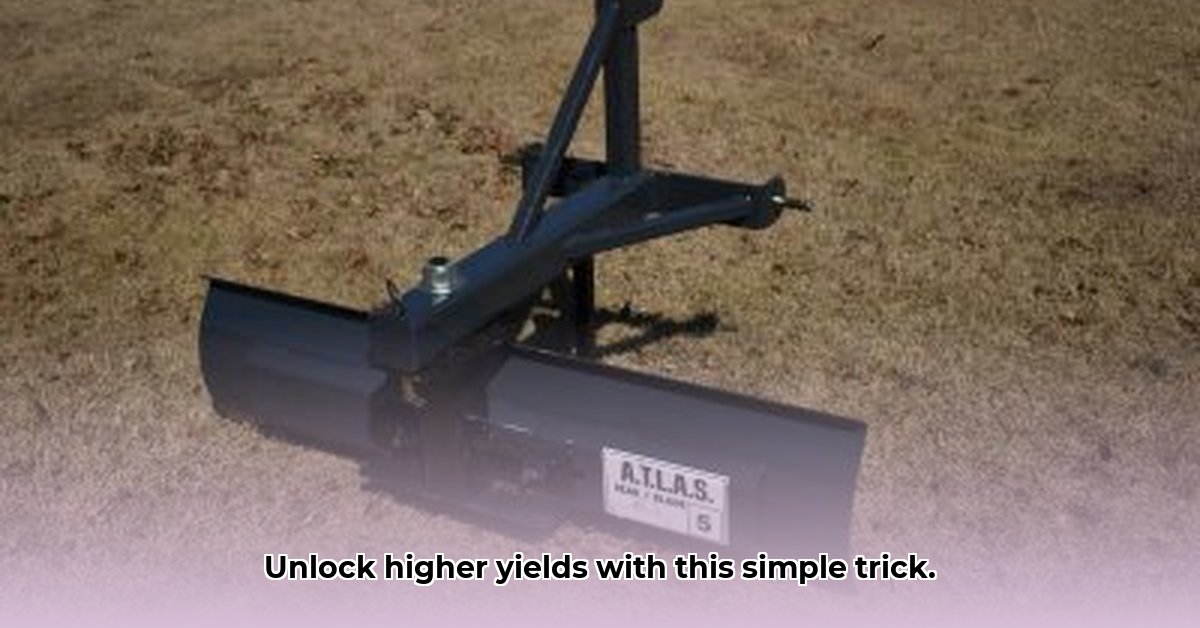
Tractor Grader Blades: Leveling Up Your Soil for Better Harvests
Healthy soil is the foundation of sustainable agriculture. Tractor grader blades, often overlooked in precision farming, offer a powerful tool for improving soil health and boosting yields. These aren't just for large-scale construction; their precision allows farmers to create ideal growing conditions, minimizing erosion and maximizing water retention. This guide provides a practical, step-by-step approach to selecting, using, and maintaining grader blades, ensuring both efficiency and environmental responsibility. But first, let's understand the "why" behind this essential tool. For more information on tractor tire options, check out tractor tires.
Why are even fields so crucial? Uneven terrain leads to water runoff, carrying away precious topsoil and nutrients. This weakens the soil, reducing yields and impacting long-term farm productivity. Grader blades mitigate this by creating level surfaces that effectively retain water and nutrients, directly supporting plant health. Dr. Anya Sharma, Soil Scientist at the University of California, Davis, emphasizes, "Proper land leveling is a cornerstone of efficient irrigation and nutrient management. It's about optimizing resource utilization and minimizing environmental impact."
Understanding the Power of Tractor Grader Blades in Sustainable Farming
Tractor grader blades offer a versatile solution for various soil management challenges. They create level fields conducive to consistent water distribution, crucial for strong plant growth. Imagine the difference between uneven fields, where water runs off carrying topsoil, and a smoothly graded field, where water is absorbed efficiently. This improved water management directly translates to healthier plants and higher yields.
Did you know that soil erosion accounts for a significant loss of arable land globally? Implementing techniques like precision grading with tractor blades can significantly reduce this loss, contributing to long-term soil health and sustainability. Moreover, the consistent water distribution provided by level fields leads to more efficient fertilizer use, further reducing environmental impact and operational costs.
Choosing the Right Blade: It's Not One-Size-Fits-All
Selecting the appropriate grader blade requires careful consideration of several factors. The right blade is determined by your specific soil type, the scale of your operation (large fields versus smaller, more intricate work), and your tractor's capabilities.
Blade Size and Shape: Larger blades are efficient for covering large areas quickly, while smaller blades offer superior maneuverability for detailed work in tighter spaces. V-blades excel at ditching, while box blades are ideal for fine grading.
Soil Type: Sandy soils require a different approach than clay soils. A blade effective in sandy soil may compact clay soil, negatively impacting drainage. Understanding your soil's characteristics is paramount.
Tractor Compatibility: Ensure your tractor possesses sufficient power and the right hitch type to safely and effectively operate the chosen blade. Consult your tractor's specifications and the blade manufacturer's recommendations.
Mastering the Art of Using Your Tractor Grader Blade: A Step-by-Step Guide
Efficient grader blade operation requires skill and precision. Follow these steps for optimal results and minimal soil compaction:
Step 1: Pre-Operation Check: Thoroughly inspect the blade and tractor for damage, loose parts, and leaks. Check fluid levels and ensure all safety systems function correctly. Safety always comes first.
Step 2: Site Preparation: Clear the area of rocks and debris that could damage the blade. Plan your grading strategy, considering natural drainage patterns.
Step 3: Blade Adjustment: Adjust the blade's angle and tilt. Begin with shallow cuts, making multiple passes to achieve the desired level. Avoid attempting too much at once.
Step 4: Grading: Overlap each pass slightly for even coverage. Maintain consistent speed to prevent uneven grading and soil compaction. Smooth, even passes are essential.
Step 5: Post-Operation Maintenance: Clean the blade thoroughly to remove mud and debris. Inspect for wear and tear, and lubricate moving parts. Regular maintenance significantly extends the blade's lifespan.
Reaping the Rewards: How Grader Blades Enhance Soil Health
Proper grader blade use delivers numerous benefits:
Erosion Control: Level fields minimize water runoff, preventing topsoil loss and preserving valuable nutrients.
Improved Water Management: Even surfaces promote better water infiltration and retention.
Enhanced Drainage: Proper grading improves drainage, preventing waterlogging and promoting healthy root growth.
Reduced Compaction (with proper technique): Minimized compaction allows for strong root systems and overall plant health.
Potential Pitfalls and How to Avoid Them
While highly beneficial, improper use can lead to issues:
- Soil Compaction: Use lighter passes and adjust the blade angle to mitigate compaction.
- Uneven Grading: Multiple passes and adjustments to tractor speed and blade angle will ensure even grading.
- Blade Damage: Regular inspections and prompt repairs prevent damage.
- Safety Concerns: Always adhere to safety regulations and receive proper training before operating the equipment.
How to Choose Sustainable Grader Blades for Efficient Soil Conservation
Choosing a sustainable grader blade involves assessing your needs, researching options, and prioritizing long-term cost savings and environmental impact. Key factors include blade material and design.
Key Takeaways:
- The right blade significantly impacts soil health and operational efficiency.
- Blade material, design, and maintenance influence costs and environmental impact.
- Soil type and grading intensity are crucial for optimal blade selection.
- Durable blades often translate to long-term cost savings and reduced fuel consumption.
- Tractor compatibility is vital for efficient and safe operation.
This guide offers a foundational understanding of tractor grader blades for sustainable agriculture. Remember, consulting with agricultural equipment specialists is always recommended to ensure optimal blade selection and efficient operation. Investing in soil health through intelligent land management translates into improved yields and a more sustainable farming operation.